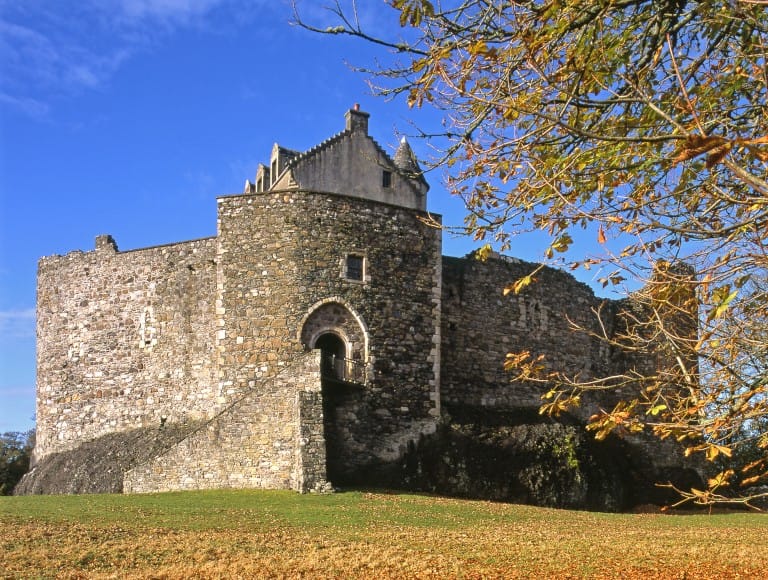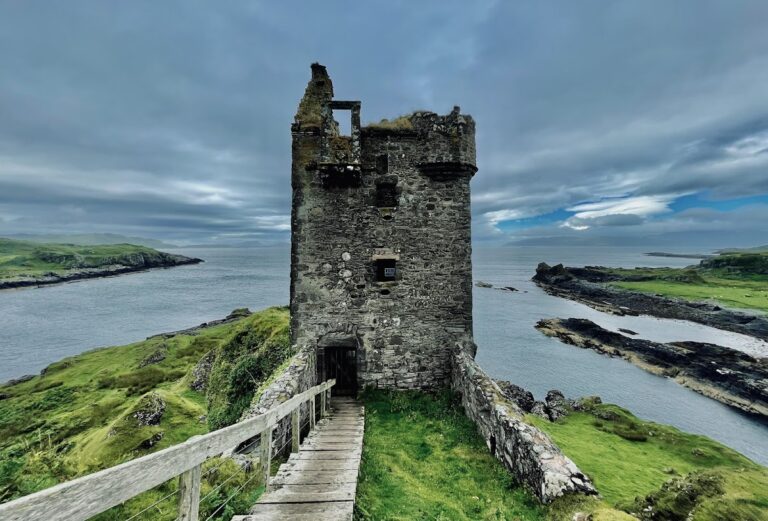Dunollie Castle: A Historic Stronghold in Scotland
Visitor Information
Google Rating: 4.4
Popularity: Low
Google Maps: View on Google Maps
Official Website: www.dunollie.org
Country: United Kingdom
Civilization: Medieval European
Remains: Military
History
Dunollie Castle is situated on a rocky hill just north of the town of Oban in Scotland. Its origins trace back to the early medieval period, when it served as an important stronghold for the Cenél Loairn, a subgroup within the kingdom of Dál Riata. This early foundation was known as “Dun Ollaigh,” reflecting its Gaelic heritage.
During the seventh and eighth centuries, Dun Ollaigh faced several violent episodes, with recorded attacks or fires occurring in the years 686, 698, and 701. After these assaults, the fortification was reconstructed in 714 under the direction of Selbach mac Ferchair, a king of Dál Riata. Archaeological findings indicate that this first fortress site was active during this period but was eventually abandoned by the tenth century.
The twelfth century introduced a significant change in ownership and political influence as the region came under the control of Somerled, a Norse-Gaelic leader who established the Kingdom of the Isles. His descendants, the MacDougalls, rose to prominence as Lords of Lorne, holding extensive territories including parts of Argyll and nearby islands. It was during the later twelfth or early thirteenth century that the original earthwork fortification was replaced with a more substantial castle, likely initiated by Dougall or his son Duncan MacDougall. By the mid-thirteenth century, the MacDougalls shifted their allegiance from Norse to Scottish rule under Ewan MacDougall’s leadership.
In the early fourteenth century, John MacDougall emerged as a key figure opposing Robert the Bruce during the Scottish Wars of Independence. John’s forces achieved victory at the Battle of Dalrigh in 1306 but were later defeated at the Pass of Brander in 1308. These conflicts resulted in the forfeiture of MacDougall lands to the Campbells, although the family eventually reclaimed Dunollie Castle.
The structure that remains today mainly dates to the fifteenth century, reflecting the MacDougalls’ continued presence. The castle endured further turmoil in the seventeenth century, being captured by the Marquis of Argyll in 1644 and later besieged and plundered by Covenanter forces in 1647. The MacDougall family regained possession in 1661, maintaining the site until 1746, when they abandoned the castle in favor of a nearby residence known as Dunollie House. Archaeological work in the late twentieth century confirmed the layers of historical construction and use, including early medieval and medieval fortifications, highlighting the site’s long and varied history.
Remains
Dunollie Castle stands as a ruined stone fortress perched on a rocky promontory overlooking surrounding waterways. The core of the remaining structure is a four-story rectangular tower located at the northeast corner of a sizable walled courtyard. This courtyard measures approximately 24.4 meters on each side and is enclosed by curtain walls reaching up to 4.6 meters in height along the northern and eastern sides. The walls vary in thickness, being thickest at the northeast corner, and constructed mainly of rubble stone bound with clay mortar.
The main tower’s entrance is situated on the ground floor of its southwest wall. Inside, the tower is arranged across several levels. A vaulted cellar lies at the base, providing storage space with a strong arched ceiling. Above this, a small hall occupies the first floor, while the second floor houses a larger hall accessible via two straight staircases. Additional upper chambers were reached by a spiral staircase, a common feature in medieval tower houses designed for efficient vertical movement. The tower once featured battlemented parapets along the roofline, though these defensive crenellations have largely fallen into ruin.
The courtyard walls contain important gateway features. The eastern curtain wall includes a restored main gate, designed to be secured by a heavy wooden beam acting as a barricade. To the north, a smaller gate was blocked at a later date with masonry work, indicating changing defensive needs or access routes over time. Within the courtyard’s enclosure once stood multiple buildings; however, these now survive only as ruins covered by vegetation.
South of the eastern gate, a Celtic cross commemorates Alexander James MacDougall, who died in 1953, and his wife Colina Edith, who passed away in 1963. This monument bears the MacDougall family coat of arms and depicts a dragon-headed galley, a traditional emblem associated with the clan’s seafaring heritage.
Today, Dunollie Castle is recognized as a Scheduled Monument, a designation that reflects its archaeological and historical importance. Despite its significance, the ruins are in a fragile and deteriorating condition, underscoring the need for ongoing conservation efforts. Excavations carried out in 1978 confirmed the presence of earlier fortifications beneath the existing structure, revealing layers of occupation dating from the seventh century through the thirteenth century, thus illuminating the castle’s deep-rooted past.










